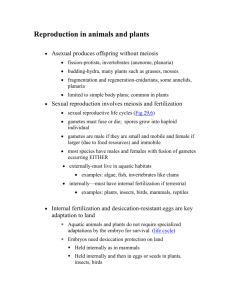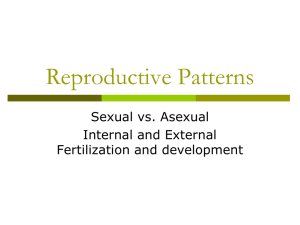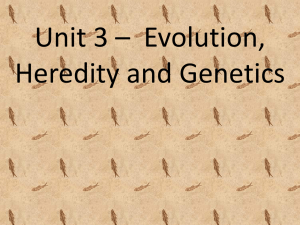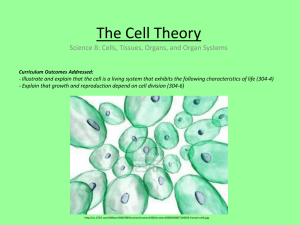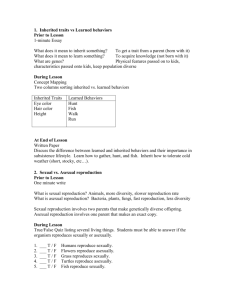Reproduction - David Brotherton CCCMC
advertisement
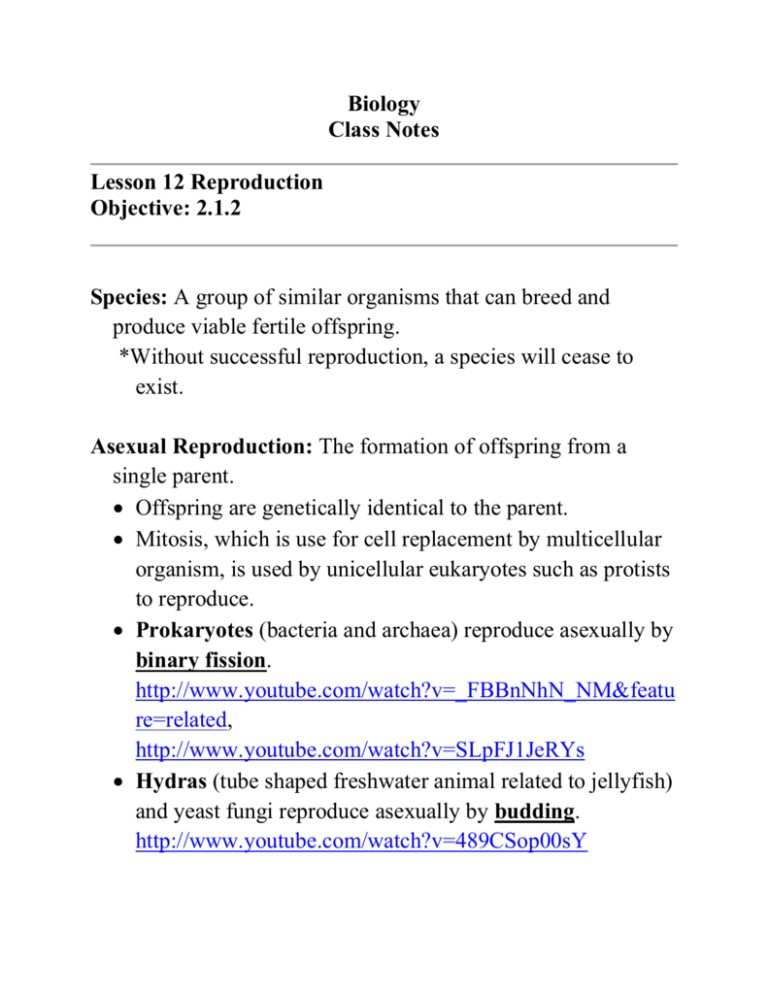
Biology Class Notes Lesson 12 Reproduction Objective: 2.1.2 Species: A group of similar organisms that can breed and produce viable fertile offspring. *Without successful reproduction, a species will cease to exist. Asexual Reproduction: The formation of offspring from a single parent. Offspring are genetically identical to the parent. Mitosis, which is use for cell replacement by multicellular organism, is used by unicellular eukaryotes such as protists to reproduce. Prokaryotes (bacteria and archaea) reproduce asexually by binary fission. http://www.youtube.com/watch?v=_FBBnNhN_NM&featu re=related, http://www.youtube.com/watch?v=SLpFJ1JeRYs Hydras (tube shaped freshwater animal related to jellyfish) and yeast fungi reproduce asexually by budding. http://www.youtube.com/watch?v=489CSop00sY Some species of sponges, worms and sea stars can reproduce asexually by fragmentation. http://www.youtube.com/watch?v=f7cXeWxxfD4 Plants reproduce asexually by sprouting new plants from roots or cutting. Sexual Reproduction: When two parent sex cells join together to form a new individual. Typically, male and female gametes join by fertilization. Earthworms are hermaphroditic, but cannot fertilize themselves. Monecious plants can fertilize themselves. Sexual Reproduction of Plants Ferns Spore: A single reproductive fern cell that can grow to become a new plant. Sporophyte: A plant structure that makes spores. Gametes: Sex cells (i.e. male sperm and female egg). Gametophyte: A plant structure that makes gametes. Zygote: A fertilized egg. 1. A spore lands in a suitable place and becomes a prothallus. 2. The prothallus produces gametes. 3. The male gamete fertilizes the female gamete. 4. A new fern develops into a mature fern. 5. More spores are produced. Angiosperms (flowering Plants) Embryo: An unborn, unhatched or dormant offspring in the process of developing. Seed: A reproductive plant structure that contains a plant embryo. 1. Pollen lands on the stigma and goes down the style to the ovary. 2. The egg in the ovary is fertilized and becomes a zygote 3. The embryo develops into a seed and is typically surrounded by a fruit. 4. The fruit lands in a new location and the seed sprouts to become a new plant. 5. The new plant forms flowers and the process is repeated. Gymnosperms (nonflowering plants) 1. Male cones produce pollen. 2. Female cones produce ovules, which contain egg cells. 3. Pollen lands on a female cone and fertilization occurs. 4. Cones expand to release the seeds, which are dispersed. 5. Seeds sprout to become new plants, which produce more male and female cones. Sexual Reproduction in Animals While a few animals such as hydras and drone bees (i.e. unfertilized) are reproduced asexually, most animals reproduce sexually. External Fertilization: Fertilized outside the female body. Sperm cells must be released into a fluid environment. Timing is controlled by the release of hormones to signal readiness. As the female begins to lay eggs, the male receives a signal and deposits sperm. Ex: Most fish and many amphibians Internal Fertilization: Fertilized inside the female body. May lead to live birth or the laying of a fertilized egg. Ex: Insects, reptiles, birds, mammals and a few aquatic animals such as sharks, aquatic mammals, and lobsters. Live Birth in Mammals All mammals reproduce sexually using internal fertilization. Mammal Groups Marsupials: Mammals that develop for a short time inside the mother’s body and then develop further in a protective pouch while attached to a nipple. Ex: Most are in Australia and include koalas, kangaroo. Ex: The only N. American marsupial is the opossum. Placental Mammals: Mammals that give birth to live young that have developed inside an organ in the mother’s body called a uterus. Placenta: An organ in pregnant females that passes nutrients oxygen to the developing embryo and carries waste away through the umbilical cord. Monotremes: Mammals they lay eggs. Ex: Echidna and duck-billed platypus. Reproduction in Fungi Fungi: A diverse group of unicellular and multicellular organisms that include: yeasts, molds, mildews, mushrooms, and bracket fungi. Can reproduce sexually by producing spores or asexually by budding (e.g. yeasts). Pros and Cons of Asexual and Sexual Reproduction Asexual Pros Only requires one parent. Is a fast way to produce many offspring. Does not require courtship or even finding a mate. Cons Leads to low genetic diversity and vulnerability to disease, environmental change, etc. Evolution occurs primarily through mutation. Sexual Pros Leads to more genetic diversity and overall fitness. Evolution occurs through mutation, natural selection and random genetic drift. Cons It is slower. Key Words: Species Asexual reproduction Sexual reproduction Spore Seed External fertilization Internal fertilization Marsupial Placental mammal Placenta
